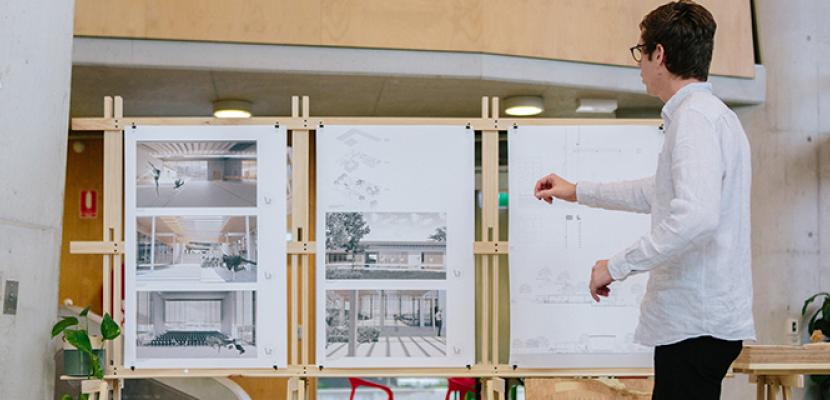Architecture is often seen as the art and science of designing and constructing buildings, but it goes much beyond the visual and functional aspects of structures. Architecture has the power to shape how we experience and interact with spaces, influencing our daily lives and the way we work. Whether in the form of a residential home, office building, or public space, architecture can significantly impact our emotions, behavior, and productivity. By creating environments that promote well-being, efficiency, and collaboration, architecture plays a key role in shaping both our personal and professional lives.
In this article, we will explore how architecture influences the way we live and work, with a focus on how design, layout, and materials can impact functionality, comfort, and overall human experience. Additionally, we will answer seven frequently asked questions (FAQs) on the topic and conclude with key takeaways that summarize the influence of architecture in our daily lives and workspaces.
1. The Power of Space Planning in Architecture
The layout and arrangement of spaces within a building can significantly affect how individuals interact with their environment. Good architectural design takes into account how space is used and how people move through it. In homes, the flow of space between rooms and the use of open-plan designs can foster a sense of freedom and ease of movement. In the workplace, a well-planned office layout can enhance communication, collaboration, and productivity.
For example, an open-concept living space can promote family interaction, providing a sense of openness and connection. Similarly, an office layout with easily accessible meeting rooms, quiet spaces for focused work, and collaborative zones can create an environment conducive to both individual tasks and group work. In contrast, poorly planned spaces with awkward layouts can hinder flow, cause frustration, and reduce efficiency.
In the Workplace: Office designs that encourage collaboration and flexible workspaces can increase creativity and foster innovation. A design that integrates shared spaces, lounges, and flexible seating allows employees to engage in spontaneous discussions and work in teams, which can result in better problem-solving and idea generation. Research has shown that a well-organized office can boost morale and reduce stress, ultimately improving productivity.
2. Natural Light and Ventilation: Enhancing Well-being and Productivity
One of the most influential elements of architectural design is the use of natural light. Exposure to natural light is known to have a profound effect on human well-being, boosting mood, energy levels, and overall health. Natural light can increase levels of serotonin in the brain, improve sleep patterns, and even reduce the risk of certain diseases. Architecture that incorporates large windows, skylights, and well-placed openings allows natural light to flood interior spaces, creating a bright and uplifting environment.
In homes, ample daylight can make a space feel more inviting and comfortable, contributing to a positive living experience. In workplaces, access to natural light has been linked to higher employee satisfaction and productivity. A well-lit office environment can reduce eye strain, fatigue, and feelings of isolation, while also fostering a sense of connection to the outdoors.
Ventilation is equally important in architectural design. Proper airflow through a building not only improves air quality but also regulates temperature and humidity levels, ensuring a comfortable environment. In office settings, poor ventilation can lead to “sick building syndrome,” where employees experience headaches, dizziness, or fatigue due to inadequate air circulation. Homes and workplaces that prioritize natural ventilation, through well-placed windows, vents, and air circulation systems, promote both physical and mental well-being.
3. Designing for Functionality and Efficiency
Functional design is a key aspect of architecture that directly impacts the way we live and work. In residential architecture, a focus on functionality can optimize space usage, ensuring that every square foot is used effectively. For example, multifunctional furniture, such as foldable tables and convertible beds, can help maximize small living spaces, making them more practical and comfortable.
In the workplace, functional design can streamline workflows and improve efficiency. For instance, offices with ergonomic furniture, adjustable desks, and task-specific zones allow employees to work more comfortably and efficiently. Thoughtful design can reduce unnecessary distractions and make it easier for employees to access the tools and resources they need. Additionally, good design ensures that spaces are accessible to everyone, including individuals with disabilities, creating an inclusive environment that enhances the well-being of all users.
Smart Technology Integration: Modern architecture increasingly incorporates smart technology, such as automated lighting, climate control, and security systems. These technologies not only improve the efficiency of a building but also enhance the convenience of living and working in that space. In homes, smart devices can help manage energy consumption, improve security, and enhance comfort. In the workplace, smart offices are equipped with sensors that monitor occupancy and adjust lighting and temperature based on real-time data, improving both comfort and sustainability.
4. Aesthetics and Emotional Impact
Architecture has the ability to influence emotions, moods, and perceptions through its aesthetic qualities. The choice of materials, colors, shapes, and textures can evoke different emotional responses, from calm and relaxation to excitement and inspiration. A well-designed environment can contribute to a sense of peace, balance, and harmony, which can improve our overall quality of life.
In residential spaces, architecture can create a sense of sanctuary, with design elements such as warm wood finishes, soft lighting, and cozy layouts that invite relaxation and comfort. For example, a home with a beautifully designed living room or bedroom can foster a sense of tranquility and restfulness.
In work environments, aesthetics play a significant role in shaping employee experiences. A workspace with a visually appealing design can boost morale, enhance creativity, and promote a positive company culture. Companies that invest in the aesthetic quality of their office spaces create a more engaging and motivating environment for employees. Elements like greenery, art installations, and natural materials can reduce stress and help employees feel more connected to their surroundings.
Biophilic Design: One of the most notable trends in modern architecture is biophilic design, which emphasizes the connection between humans and nature. Integrating elements such as plants, natural materials, and outdoor spaces into the design of buildings can improve emotional well-being and productivity. Research has shown that people working in environments with biophilic elements tend to be more focused, engaged, and creative.
5. Sustainability: Designing for the Future
Sustainable architecture is an important consideration in the modern world, where environmental concerns are increasingly at the forefront of global conversations. Buildings that are designed with sustainability in mind not only reduce environmental impact but also contribute to long-term cost savings and improved quality of life.
Sustainable architecture incorporates energy-efficient features, such as solar panels, green roofs, and high-performance insulation, to reduce energy consumption and lower utility costs. In addition, the use of eco-friendly materials, such as recycled or locally sourced products, minimizes the carbon footprint of a building. This approach to design is becoming more prevalent in both residential and commercial architecture, as people and businesses alike prioritize sustainability in their living and working environments.
For businesses, investing in green buildings can enhance brand reputation, attract eco-conscious employees, and reduce operational costs. Companies that adopt sustainable practices also contribute to a healthier environment, aligning with growing consumer demand for environmentally responsible products and services.
6. Social and Cultural Impact
Architecture also has a profound impact on society and culture. Buildings and public spaces can serve as symbols of identity, history, and community values. Well-designed urban spaces foster a sense of belonging and pride, encouraging social interaction and engagement.
For instance, public buildings such as museums, theaters, and libraries can serve as cultural hubs, bringing people together and offering opportunities for learning, entertainment, and collaboration. Urban planning and architecture that prioritize accessibility, inclusivity, and community spaces can foster stronger social bonds and create a sense of civic pride.
Architecture can also influence the way people interact with their environment and with each other. In cities, pedestrian-friendly streets, parks, and plazas encourage social interaction and physical activity. In contrast, poorly designed urban spaces with little regard for human interaction can lead to isolation, segregation, and social fragmentation.
7 Frequently Asked Questions (FAQs) about Architecture’s Influence on Our Lives
- How does architecture affect our mental health? Architecture influences mental health by creating environments that either reduce or increase stress. Spaces with natural light, open layouts, and calming aesthetics promote well-being, while dark, cramped, or noisy spaces can negatively affect mental health.
- What is the role of architecture in improving workplace productivity? A well-designed office space can improve productivity by providing employees with comfortable, functional, and stimulating environments. Features like ergonomic furniture, access to natural light, and collaborative workspaces can enhance focus and creativity.
- How can sustainable architecture benefit us? Sustainable architecture reduces environmental impact by conserving resources, improving energy efficiency, and minimizing waste. It also leads to long-term cost savings and healthier living and working environments.
- What are the key elements of biophilic design? Biophilic design incorporates natural elements, such as plants, natural lighting, outdoor views, and materials like wood or stone, into the built environment to improve well-being and connection with nature.
- How does architecture influence the way we interact with others? Architecture affects social interaction by designing spaces that encourage or discourage communication and community engagement. Public spaces, social hubs, and open layouts facilitate interaction, while isolated or poorly designed environments may hinder connection.
- What role does space planning play in residential architecture? Space planning is crucial in residential design, as it ensures optimal use of available space, improving functionality and comfort. Thoughtful layouts can enhance daily routines, provide privacy, and create a harmonious living environment.
- Can architectural design affect a city’s identity? Yes, architecture plays a key role in shaping a city’s identity. Iconic landmarks, well-planned urban spaces, and culturally significant buildings contribute to the city’s aesthetic appeal and cultural narrative.
Conclusion
Architecture is much more than the creation of buildings and structures; it is a reflection of how we live, work, and interact with the world around us. The design of spaces can have a profound influence on our emotional and psychological well-being, productivity, and social interactions. By incorporating thoughtful space planning, natural light, functionality, aesthetics, sustainability, and social impact into architectural design, we can create environments that enhance our quality of life and improve our work experiences.
As our understanding of architecture continues to evolve, there is a growing recognition of its potential to foster healthier, more productive, and more sustainable communities. Whether at home or at work, the spaces we inhabit shape who we are and how we engage with the world. Thoughtfully designed architecture can transform the way we live and work for the better.
Key Takeaways:
- Space Planning: Proper layout design promotes efficiency, comfort, and collaboration in both living and workspaces.
- Natural Light and Ventilation: These elements improve mood, health, and productivity, making them crucial in architectural design.
- Functionality: Architecture should prioritize functionality to make spaces more practical, efficient, and comfortable.
- Aesthetics: Thoughtful design enhances emotional well-being and fosters a sense of connection to the environment.
- Sustainability: Green architecture promotes environmental health and cost savings, benefiting both residents and the planet.
- Social Impact: Public spaces and buildings play a crucial role in fostering community, social interaction, and cultural identity.

